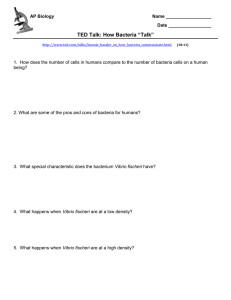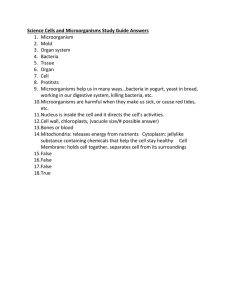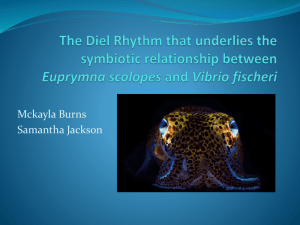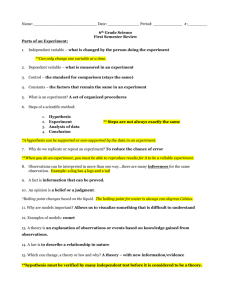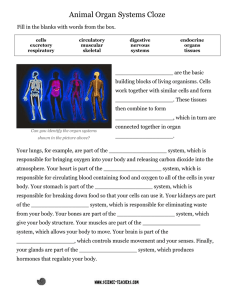Phillip Plourde
advertisement
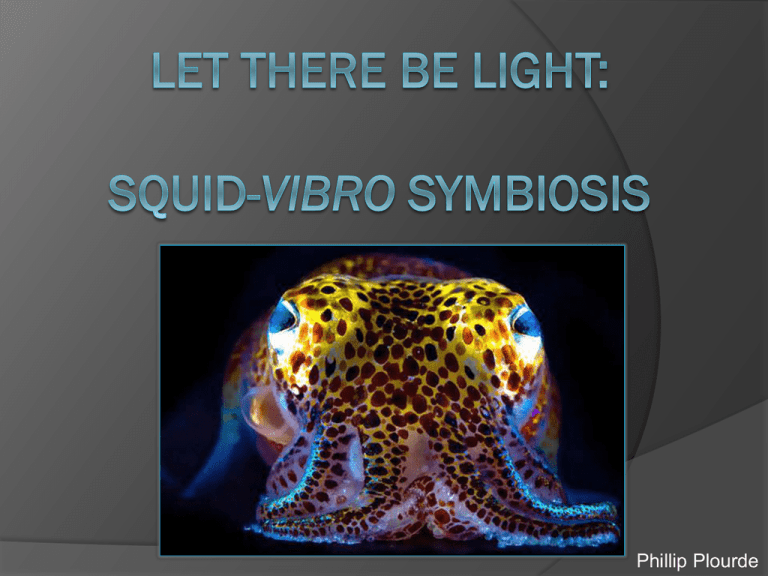
Phillip Plourde Symbiosis The formation of an often long-term association or alliance between two or more individual organisms Symbiont Transmission Classified as either Vertical or Horizontal Vertical Transmission – The microbial partner is passed directly from the parent to the offspring via the egg. Example – Coral and Zooxanthella Symbiont Transmission Horizontal Transmission – each new generation of the host acquires the Symbiont directly from the surrounding environment. Example – Mammalian intestinal epithelial and Bacteria Study Organism Hawaiian bobtail squid Euprymna scolopes Symbiont – Vibrio fischeri bacteria Vibro Symbiosis The squid establishes a very tight horizontally transmitted symbiotic relationship with the bioluminescent bacteria Extreme specificity between host and symbiont Light produced by the bacterial facilitates counter illumination This illumination helps the host avoid predators during their nocturnal activities. Predator Avoidance Mechanism At night Symbiotic bacteria are housed in a “light organ” deep within the organism Host emits luminescence from its ventral surface Emitted light mimics downwelling moon and star light thereby obscuring its silhouette Similar purpose as dual dorsal ventral coloration of many animal in nature. ie sharks, birds etc. Colonization of Host Problems: The symbiont is relatively rare in sea water (<0.1% of the bacterioplankton population) How do you bring the two together? How do you make sure only the intended microbe enters the host when there is such a plethora of potential invaders in the environment? Host and bacteria must solve these problems if they are to be successful Transmission At dawn colonized squid expel about 95% of V. fischeri prior to burrowing into the sand Behaviour serves as a means of local enhancement, seeding the environment with more symbionts Enhancement helps juveniles during colonization which begins immediately after hatching Mechanisms of Transmission 1. Water brought into mantel cavity and drawn across the light organ. Light organ Bacteria must enter the pores to access the crypts where permanent colonization can occur Pores about 15µm across Mechanisms of Transmission Water being drawn across the light organ alone is not enough. Interesting fact: 1µl / ventilation 2 ventilations / second 500 bacteria / ml sea water Works out to < 1 bacteria / ventilation Not Very good odds Mechanisms of Transmission Facilitated active capture 2. Host has evolved structures that assist in bringing V. fischeri into the light organ. • Structure located on inside of mantel cavity • Ciliated epithelia bring materials into the vicinity of the pores Mechanisms of Transmission 3. Enriching symbiont via Mucosal aggregation Before bacteria enters the pore leading to the light organ it must first become the dominant microbe Cilia cells secrete a mucus in which the symbionts gather By some as yet unknown mechanism the mucus composition helps to filter out microbes other then the desired V. fischeri Possibly due to chemotaxis towards N-acetylneuraminic acid, a component of squid mucus At this stage V. fischeri becomes the dominant microbe in the mucus Mechanisms of Transmission After some time clusters migrate into the ducts and eventually into the deep crypts within the light organ V. fischeri must overcome a number of difficult obstacles while migrating into the light organ including: High concentrations of nitric oxide synthase Presence of halide peroxidase – hypohalous acid Dense cilia that beat in an outward direction All probably important in keeping out harmful microbes and help to control the symbionts Mechanisms of Transmission At each important step the luminescent bacteria have been concentrated and finally undergone winnowing resulting in selection for the specific symbiont Mechanisms of Transmission The whole process of colonization is very time sensitive, requiring certain things to happen within a constricted time frame Light Organ Development Once V. fischeri colonize the light organ they initiate some reversible and permanent changes in the host morphology! Light Organ Development Changes include: Initiation of bioluminescence Swelling of light organ cells Constriction of the ducts (reversible) Cessation of mucus shedding (reversible) Loss of surface epithelium (permanent) Likely that these changes would help to limit other microbes from infecting the host Symbiont Adaptations Number of mutants have been identified that lack the ability to colonize the squid These shed some light on the important features of the bacteria Motility – mutants that lack motility can not fight the microcurrents created by cilia at the pores and as such can not colonize the host See that V. fischeri has evolved to be highly motile Symbiont Adaptations Oxidative stress defences – mutants that have defective putative aerobic and anaerobic NO-inactivating genes can not deal with the various oxidative stresses imposed by the host See that V. fischeri has evolved enzymatic mechanism to deal with the oxidative stress Light Production If bacteria colonize the squid that are unable to produce light they are eliminated and out competed by wild type bacteria Likely due to monitoring of the luciferase metabolic pathway by the host Conclusions Colonization occurs in a series of stages Each step confers greater specificity between the host and the symbiont V. fischeri is not a passive player in successful establishment of symbiosis References Nyholm, S., McFall-Ngai, M. 2004. The Winnowing: Establishing The SquidVibrio Symbiosis, Nature Reviews Microbiology. 2. Questions? Questions?

